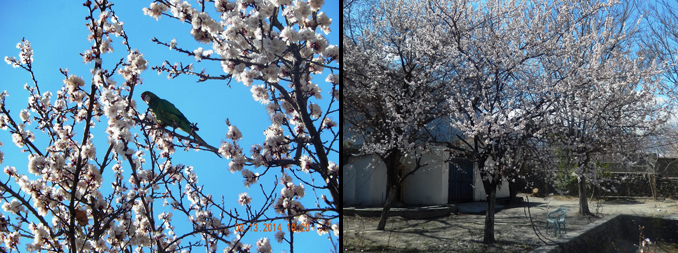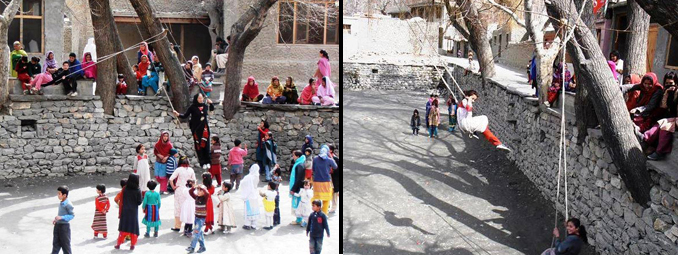Written by: Shahana Shah
Posted on: April 01, 2014 |  | 中文
| 中文
Table spread for Navroz
Even the laziest and the sleepiest individual in Hunza or Gilgit would eagerly set the alarm for 5 a.m. the night before Navroz. No one wants to miss the morning of the ‘New Day,’ the beginning of spring on the 21st of March. It begins with everyone congregating for special prayers and a communal breakfast to celebrate the Persian New Year in Pakistan’s Gilgit-Baltistan region, perhaps most zealously so in the valley of Hunza. Though originating in ancient Persia Navroz is celebrated in different parts of the world and has its local variants.
Although non-religious in its essence, Navroz has spiritual overtones for the Shia and Ismaili communities of Gilgit-Baltistan, as a result of the roots of their spiritual traditions in Iran and its subsequent cultural influence. The origin of Navroz in the practices of these communities goes back to the earliest celebration of this day by Salman the Persian, the Prophet Muhammad (Peace Be Upon Him)’s companion and Shehrbano, a Persian princess married to Hussain, the Prophet (P.B.U.H.)’s grandson. The faith based traditions on Navroz include a recitation of the Quran, the singing of devotional poetry in Persian and the congregational recitation of the durood sharif (blessing of the Prophet, P.B.U.H). Therefore it is a spring fete as well as the mark of new spiritual awakening, signifying growth and rejuvenation in both man’s inner and outer worlds.
 |
From an apricot orchard in bloom Gilgit in Spring |
It is right around Navroz that the fruit orchards are in blossom in Gilgit, though it takes a little more time for the soft pastel shades of apricot, peach and almond flowers to bloom in Hunza which is at a higher altitude. The air is intoxicatingly fragrant, humming with bees and full of gentle birdsong in these first warm spring days when the sun filters through the soft petals. People have been rejoicing in this burst of color following the long harsh winters of the north in different ways for generations. Some traditions have remained consistent while others have faded away with time.
The Mirs of Hunza had an important role in the Navroz celebrations while the valley was still a tiny princely state ruled by them. As on other important occasions, a big fair would be organized with traditional men’s dancing being an integral part. The Mir would ride a horse to the Navroz fair with his entourage. He would be seated at a special throne and declare the event open. The ladies of the royal family would look on at the proceedings from high balconies. The last of the dried meat from the winter stock, called ‘old meat’, would be consumed on this special day. The tradition of drying meat in winter continues to this day and it is particularly preferred for making soup with.
 |
Fried bread Homemade bread Bukak |
Two most integral and popular traditions of Navroz have still remained the same. The first is of course the special foods made on this day. A particular kind of beans, locally called bukak, is an essential item. Another dish, berikutz, is made by layering large, very thin chapattis (flat round bread) with powdered apricot kernels and apricot or walnut oil. Homemade varieties of bread, dry fruits and sweets are also part of the Navroz festivities. The other tradition is specific to women and young girls who dress in brightly colored clothes and gather in orchards or fields and hang rope swings on trees to spend a long day of swinging to their hearts’ content. Men are barred from this enjoyment and this makes Navroz more of a girls’ day.
 |
Women celebrating Navroz in Altit, Hunza (Photograph by Shafqat Hussain) |
It is a festival for the community as well as the family. People wish each other Navroz Mubarak and a big lunch is prepared at home. Sometimes relatives may visit each other or send over food. Many even make New Year resolutions! It is truly the beginning of a new time for everyone as the confines of winter give way to the arrival of spring.
Navroz differs from other spring festivals from around the world in its simplicity and emphasis on celebrating the spiritual. It is about a human soul letting go of the past and starting afresh, reflected in the blossoming of new life in nature. It is a time for hope and renewal, for fresh effort and continued human endeavor.
You may also like: